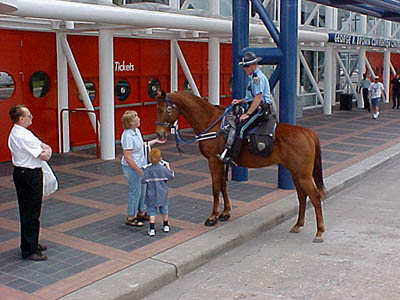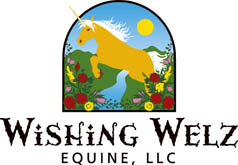
Above, Officer Sokoloski and Shadow, a 4 yo Dutch Warmblood, at the convention center, wearing Marquis Hoof Boots.
City of Houston Police Horses Go Barefoot,
part 2
Houston Police Department Mounted Unit—Barefoot Program
by Greg Sokoloski, Police Officer
City of Houston, Texas

Above, Officer Sokoloski and Shadow, a 4 yo Dutch Warmblood, at the convention
center, wearing Marquis Hoof Boots.
The Houston Police Department’s Mounted Patrol Unit currently has 34
full time Police Horses, as well as 2 horses in training. Since the winter issue
(18) of The Horses Hoof, we have gone from 11 barefoot horses to 21 barefoot
horses. We will be adding an additional horse, now shod, to the barefoot program
in August.
We have made great strides in not only adding more horses into the Barefoot
Program, but have also sent two of the Units’ Officers to Martha Olivo’s
Hoof Groom Course. Officer Danny Pryor attended the Hoof Groom Course held at
Darolyn Butler’s Ranch in Humble Texas, in December, 2004. Officer Scott
Berry just returned from the Hoof Groom Course held at Texas A&M’s
Cavalry barn. The Texas A&M Parsons Mounted Cavalry Unit, under the direction
of Bob Byrns, will now also transition their Unit’s horses from being shod
to barefoot. The Houston Police Mounted Unit will now have 3 Hoof Grooms to
continue the progress of the Unit’s barefoot horses.
We have now completed an Access Database, under the direction of Officer Leslie
Wills, that will include vital information to track not only all the Department’s
horses’ daily activity, but also all the vital information on the barefoot
horses. We are able to track when we pull shoes, to the time the rider and horse
are used downtown, along with all events our barefoot horses worked. We will
be able to input pictures and measurements of before and after, the condition
of the barefoot horses’ hooves, track each trim for the barefoot horses,
track evaluations from the Officers on daily patrol days and special events,
downtime a horse will have, and cost comparisons between shod and barefoot horses.
The current journey for the barefoot horses has not been without roadblocks.
As we pulled shoes and began trimming some of the horses, we found very deformed
and unbalanced hooves. The horses had compensated for these imbalances for years.
The transformation for some begins with relief, and the ability to move without
restriction.
Shortly after pulling the shoes, the healing process begins. The ability the
horse has to heal and reshape its hooves into correct form is amazing. During
the process of healing, enormous changes are occurring, not only outside, but
also inside. The most important part of this process is to allow the horse to
heal by keeping the hoof form correct and providing turnout, so that the horse
can move as much as possible.
The healing time for the majority of our horses has been very short. We are
now seeing that the badly deformed hooves of a few of our horses will take time.
Both Lt. Randy Wallace and Captain Mary Lentschke, Commanders of the Mounted
Unit, have sat down with Martha Olivo and viewed one of her dissections of a
cadaver leg. They both have an understanding of the importance of a barefoot
horse, and what to expect once shoes are pulled and the barefoot process begins.
This in itself is instrumental, because we now have an understanding of barefoot
horses from the Officers that trim, the Officers and Supervisors that ride barefoot
horses, and the managers of the Mounted Unit.
After the healing has finished, the process of the barefoot horse adapting
to his environment will take place. The Houston Police Horses will walk, trot
and canter over varying types of terrain. In the Downtown area, we have asphalt,
concrete, pavers, marble, construction areas, and other types of road and walkway
surfaces. The one issue Officers first understand is how much better footing
and traction the barefoot horses have. The Officers understand that barefoot
horses have better feeling in their hooves, and have the ability to adjust immediately
once the hoof is placed on the ground.
Another issue is how much softer the barefoot horse walks. We have a few horses
we call “ground pounders,” who constantly slam their feet into the
ground. Going barefoot has made these horses walk softer, slower, and much more
comfortable in all their gaits. We have also found that horses thought to have
“training” issues could have been that way due to pain and the constant
pounding on hard surfaces with steel shoes.
During times of transition from shoes to barefoot, and in situations that dictate
more protection, we will use hoof boots. We currently have in our supply the
Marquis, Old Mac’s, and Easyboot Epics hoof boots. All have been effective,
and offer protection to the unit’s barefoot horses. Some of the pictures
demonstrate crowd control situations—we will use hoof boots to protect
against any debris or projectiles thrown at us or encountered on the ground.
We have started the barefoot trim on one of our horses with navicular. Joey
was donated to the unit in 1998. He first started with lameness in November
of 2003. Treatments and stall rest continued until he was finally put back on
the streets in January 2005. In April 2005, he was once again lame and unable
to continue on the streets. I was given the go ahead by the Unit’s Vet
and allowed to pull his shoes and trim his hooves.
Within 2 weeks, I was riding him in the arena, then out to the Bush Intercontinental
Equestrian Trails, and finally Downtown Houston. I have been working him in
the Marquis Hoof Boots downtown with no problems. We will continue with Joey
being barefoot and allow more time until we see if he can consistently go downtown
and do his job as a police horse.
As I mentioned previously, going barefoot is sometimes a long, tedious endeavor
for some horses. Cadence has been one of these. Known for being lame off and
on, Cadence was started in the barefoot program in March, 2005. He had seriously
underrun heels, long toes, and a lot of sole and heel pressure. Cadence was
removed from duty until approximately May. Finally the day to resume duty came,
and he was assigned to Hermann Park. He seemed to be adjusting very well until
June. It was noted by his Officer that he was becoming sorer every day until
we finally removed him once again from duty. He is bruised and sore from trying
to transition his body to the correct conformation to go with his more balanced
trim. We will continue to allow the healing process to occur, and eventually
allow him to return to his position within the Mounted Patrol.
In closing, I want to once again stress that the horse’s ability to adapt
to the barefoot trim is amazing to witness. Humans must first and foremost remember
not all horses are the same. If there are physical problems along with bad hoof
conformation, the healing process can be lengthy, but you must not give up.
The hoof is an amazing piece of equipment, and the horse’s well being—and
sometimes their lives—depend on it. Our horses are so much healthier and
happier. People have noticed not only better dispositions, but glossier coats,
along with much less downtime.
If anyone ever comes to Houston, they are welcome to stop by and visit our
facility, at 300 N. Post Oak Lane. You can also contact me, Officer Greg Sokoloski
at (713) 812-5158. Come see for yourself what a wonder the barefoot program
is.
Greg Sokoloski, Police Officer,
City of Houston, Texas
Phone: 713-812-5158
Click here to read Part 1 of this article.
Article published in The Horse's Hoof Magazine Issue 20, Summer 2005
Note: Photos are provided for reference and educational purposes only, and are not meant to indicate guidelines for trimming. Every horse should be trimmed as an individual. Opinions vary as to what constitutes "correct" but keep in mind - there are NO PERFECT FEET, not even in the wild. Owners are cautioned to seek professional help for the trimming of their own horse's feet. Owner trimming of pathological feet is not advised. Photos may not be reproduced, copied, or distributed in any way.
©2006 by The Horse's Hoof. All rights reserved. No part of these publications may be reproduced by any means whatsoever without the written permission of the publisher and/or authors. The information contained within these articles is intended for educational purposes only, and not for diagnosing or medicinally prescribing in any way. Readers are cautioned to seek expert advice from a qualified health professional before pursuing any form of treatment on their animals. Opinions expressed herein are those of the authors and do not necessarily reflect those of the publisher.
The Horse's Hoof Website
Home - About Us -
Articles - Barefoot Performance - Barefoot
Stories - Hoof Gallery
- Natural
Horse Care - EPSM
- Events - Trimmers
- Experts - Friends
- Classified - Resources
- News - Links
- Strasser
Hoofcare Links
To go shopping or subscribe to our magazine, please click here: The
Horse's Hoof Store
If you don't see a column to the left: To view the frames version of this site, please click here: TheHorsesHoof.com
The Horse's Hoof is a division of:

The Horse's Hoof
P.O. Box 1969
Queen Creek, AZ 85142
Phone (623) 935-1823
Message Phone: 1-623-935-1823
(Leave a message anytime.)
Email: editor @ TheHorsesHoof.com (delete spaces)